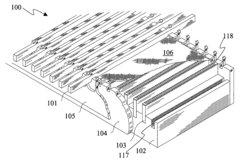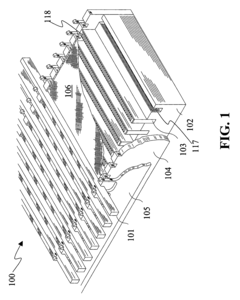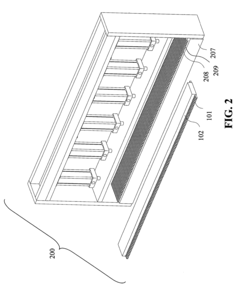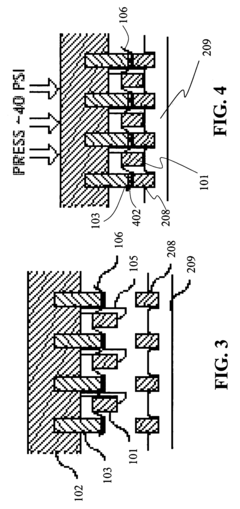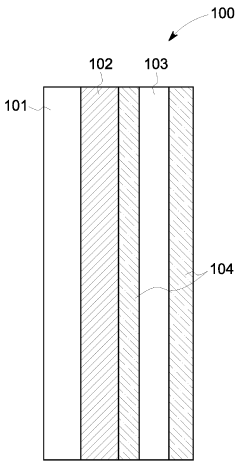Kevlar's Expansion into High-Temperature Environments
JUL 10, 20259 MIN READ
Generate Your Research Report Instantly with AI Agent
Patsnap Eureka helps you evaluate technical feasibility & market potential.
Kevlar Evolution
Kevlar, a high-strength synthetic fiber developed by DuPont in the 1960s, has undergone significant evolution since its inception. Initially designed for use in lightweight, high-strength tires, Kevlar's exceptional properties quickly led to its adoption in various applications beyond automotive use. The fiber's journey into high-temperature environments marks a crucial phase in its technological progression.
In the 1970s and 1980s, researchers began exploring Kevlar's potential for heat-resistant applications. This period saw the development of new manufacturing processes and chemical treatments to enhance the fiber's thermal stability. The introduction of Kevlar 29 and Kevlar 49 variants during this time expanded the material's temperature range, allowing for its use in more demanding environments.
The 1990s brought about a focus on improving Kevlar's performance under extreme conditions. Scientists worked on modifying the polymer structure to increase its resistance to degradation at elevated temperatures. This research led to the creation of specialized Kevlar blends and composites that could withstand higher temperatures while maintaining their strength and lightweight properties.
The early 2000s marked a significant breakthrough with the development of Kevlar XP, a next-generation fiber designed for enhanced ballistic and stab resistance. This innovation also contributed to improved heat resistance, as the new fiber structure provided better stability under thermal stress. Concurrently, advancements in coating technologies allowed for the application of heat-resistant layers to Kevlar fabrics, further expanding their high-temperature capabilities.
In recent years, the focus has shifted towards nanotechnology and molecular engineering to push Kevlar's temperature limits even further. Researchers have been experimenting with incorporating nanoparticles and creating hybrid materials that combine Kevlar with other heat-resistant substances. These efforts aim to develop Kevlar-based materials capable of withstanding temperatures well beyond their current limits while retaining their signature strength-to-weight ratio.
The evolution of Kevlar for high-temperature environments has also been driven by demands from specific industries. Aerospace, firefighting, and industrial manufacturing sectors have been particularly influential in pushing for advancements. This has led to the development of specialized Kevlar products tailored for high-heat applications, such as fire-resistant clothing, heat shields, and high-temperature filtration systems.
As Kevlar continues to evolve, researchers are exploring new frontiers in material science. Current areas of focus include self-healing Kevlar composites that can repair thermal damage, and smart Kevlar fabrics that can adapt to changing temperature conditions. These innovations promise to further expand Kevlar's role in high-temperature environments, cementing its position as a critical material in advanced engineering and protective applications.
In the 1970s and 1980s, researchers began exploring Kevlar's potential for heat-resistant applications. This period saw the development of new manufacturing processes and chemical treatments to enhance the fiber's thermal stability. The introduction of Kevlar 29 and Kevlar 49 variants during this time expanded the material's temperature range, allowing for its use in more demanding environments.
The 1990s brought about a focus on improving Kevlar's performance under extreme conditions. Scientists worked on modifying the polymer structure to increase its resistance to degradation at elevated temperatures. This research led to the creation of specialized Kevlar blends and composites that could withstand higher temperatures while maintaining their strength and lightweight properties.
The early 2000s marked a significant breakthrough with the development of Kevlar XP, a next-generation fiber designed for enhanced ballistic and stab resistance. This innovation also contributed to improved heat resistance, as the new fiber structure provided better stability under thermal stress. Concurrently, advancements in coating technologies allowed for the application of heat-resistant layers to Kevlar fabrics, further expanding their high-temperature capabilities.
In recent years, the focus has shifted towards nanotechnology and molecular engineering to push Kevlar's temperature limits even further. Researchers have been experimenting with incorporating nanoparticles and creating hybrid materials that combine Kevlar with other heat-resistant substances. These efforts aim to develop Kevlar-based materials capable of withstanding temperatures well beyond their current limits while retaining their signature strength-to-weight ratio.
The evolution of Kevlar for high-temperature environments has also been driven by demands from specific industries. Aerospace, firefighting, and industrial manufacturing sectors have been particularly influential in pushing for advancements. This has led to the development of specialized Kevlar products tailored for high-heat applications, such as fire-resistant clothing, heat shields, and high-temperature filtration systems.
As Kevlar continues to evolve, researchers are exploring new frontiers in material science. Current areas of focus include self-healing Kevlar composites that can repair thermal damage, and smart Kevlar fabrics that can adapt to changing temperature conditions. These innovations promise to further expand Kevlar's role in high-temperature environments, cementing its position as a critical material in advanced engineering and protective applications.
High-Temp Market Demand
The demand for high-temperature resistant materials has been steadily increasing across various industries, driven by the need for enhanced performance and durability in extreme environments. Kevlar, known for its exceptional strength-to-weight ratio and heat resistance, is well-positioned to capitalize on this growing market demand by expanding its applications into high-temperature environments.
In the aerospace and automotive sectors, there is a significant push for lightweight materials that can withstand high temperatures, particularly in engine components and exhaust systems. The aerospace industry, in particular, is seeking materials that can maintain their structural integrity at temperatures exceeding 300°C (572°F) for extended periods. This demand is fueled by the development of more efficient and powerful engines, as well as the increasing use of composite materials in aircraft structures.
The oil and gas industry presents another substantial market opportunity for high-temperature Kevlar applications. As exploration and extraction activities move into deeper and more challenging environments, there is a growing need for materials that can withstand extreme temperatures and pressures. Kevlar-reinforced components in drilling equipment, pipelines, and offshore platforms could significantly enhance operational safety and efficiency.
In the manufacturing sector, high-temperature resistant Kevlar could find applications in industrial furnaces, kilns, and other high-heat processing equipment. The ability to withstand prolonged exposure to elevated temperatures while maintaining its structural properties makes Kevlar an attractive option for insulation and protective gear in these environments.
The renewable energy sector, particularly in solar and geothermal power generation, also presents a promising market for high-temperature Kevlar applications. As these technologies advance and operate at higher temperatures to improve efficiency, the demand for materials that can withstand these conditions without degradation is increasing.
Furthermore, the fire safety and personal protective equipment (PPE) markets show significant potential for high-temperature Kevlar applications. Firefighters, industrial workers, and military personnel require gear that offers both heat resistance and flexibility, creating a niche market for advanced Kevlar-based materials.
Market analysts project that the global high-temperature resistant materials market will experience substantial growth in the coming years. This growth is attributed to increasing industrialization, stringent safety regulations, and the continuous push for improved performance in extreme environments across multiple sectors.
In the aerospace and automotive sectors, there is a significant push for lightweight materials that can withstand high temperatures, particularly in engine components and exhaust systems. The aerospace industry, in particular, is seeking materials that can maintain their structural integrity at temperatures exceeding 300°C (572°F) for extended periods. This demand is fueled by the development of more efficient and powerful engines, as well as the increasing use of composite materials in aircraft structures.
The oil and gas industry presents another substantial market opportunity for high-temperature Kevlar applications. As exploration and extraction activities move into deeper and more challenging environments, there is a growing need for materials that can withstand extreme temperatures and pressures. Kevlar-reinforced components in drilling equipment, pipelines, and offshore platforms could significantly enhance operational safety and efficiency.
In the manufacturing sector, high-temperature resistant Kevlar could find applications in industrial furnaces, kilns, and other high-heat processing equipment. The ability to withstand prolonged exposure to elevated temperatures while maintaining its structural properties makes Kevlar an attractive option for insulation and protective gear in these environments.
The renewable energy sector, particularly in solar and geothermal power generation, also presents a promising market for high-temperature Kevlar applications. As these technologies advance and operate at higher temperatures to improve efficiency, the demand for materials that can withstand these conditions without degradation is increasing.
Furthermore, the fire safety and personal protective equipment (PPE) markets show significant potential for high-temperature Kevlar applications. Firefighters, industrial workers, and military personnel require gear that offers both heat resistance and flexibility, creating a niche market for advanced Kevlar-based materials.
Market analysts project that the global high-temperature resistant materials market will experience substantial growth in the coming years. This growth is attributed to increasing industrialization, stringent safety regulations, and the continuous push for improved performance in extreme environments across multiple sectors.
Thermal Challenges
Kevlar's exceptional strength-to-weight ratio and heat resistance have made it a staple in various high-performance applications. However, as industries push the boundaries of material capabilities, Kevlar faces significant thermal challenges in extreme temperature environments. The primary issue lies in maintaining its structural integrity and mechanical properties at elevated temperatures.
One of the key thermal challenges for Kevlar is its glass transition temperature (Tg), which occurs around 330°C. As temperatures approach this point, the polymer chains begin to move more freely, leading to a significant reduction in strength and stiffness. This limitation restricts Kevlar's use in applications that require sustained performance at high temperatures, such as aerospace components or advanced industrial processes.
Another critical thermal challenge is the degradation of Kevlar fibers under prolonged exposure to high temperatures. While Kevlar exhibits good short-term heat resistance, extended exposure can lead to chemical changes in the polymer structure, resulting in a gradual loss of mechanical properties. This degradation process accelerates as temperatures increase, potentially compromising the material's long-term reliability in high-temperature environments.
The thermal expansion of Kevlar presents an additional challenge, particularly in composite structures. Although Kevlar has a relatively low coefficient of thermal expansion compared to many metals, mismatches with other materials in composite systems can lead to internal stresses and potential delamination under thermal cycling conditions. This issue becomes more pronounced in applications with large temperature fluctuations or rapid heating and cooling cycles.
Heat transfer characteristics of Kevlar also pose challenges in certain applications. While Kevlar has low thermal conductivity, which can be advantageous for insulation purposes, it can be a drawback in scenarios where heat dissipation is crucial. This limitation can lead to localized heating and potential thermal degradation in high-heat-flux environments.
Addressing these thermal challenges requires innovative approaches in material science and engineering. Researchers are exploring various strategies, including the development of new Kevlar variants with enhanced thermal stability, the incorporation of heat-resistant additives, and the creation of hybrid materials that combine Kevlar's strengths with the thermal properties of other materials. These efforts aim to expand Kevlar's operational temperature range and open up new possibilities for its application in extreme thermal environments.
One of the key thermal challenges for Kevlar is its glass transition temperature (Tg), which occurs around 330°C. As temperatures approach this point, the polymer chains begin to move more freely, leading to a significant reduction in strength and stiffness. This limitation restricts Kevlar's use in applications that require sustained performance at high temperatures, such as aerospace components or advanced industrial processes.
Another critical thermal challenge is the degradation of Kevlar fibers under prolonged exposure to high temperatures. While Kevlar exhibits good short-term heat resistance, extended exposure can lead to chemical changes in the polymer structure, resulting in a gradual loss of mechanical properties. This degradation process accelerates as temperatures increase, potentially compromising the material's long-term reliability in high-temperature environments.
The thermal expansion of Kevlar presents an additional challenge, particularly in composite structures. Although Kevlar has a relatively low coefficient of thermal expansion compared to many metals, mismatches with other materials in composite systems can lead to internal stresses and potential delamination under thermal cycling conditions. This issue becomes more pronounced in applications with large temperature fluctuations or rapid heating and cooling cycles.
Heat transfer characteristics of Kevlar also pose challenges in certain applications. While Kevlar has low thermal conductivity, which can be advantageous for insulation purposes, it can be a drawback in scenarios where heat dissipation is crucial. This limitation can lead to localized heating and potential thermal degradation in high-heat-flux environments.
Addressing these thermal challenges requires innovative approaches in material science and engineering. Researchers are exploring various strategies, including the development of new Kevlar variants with enhanced thermal stability, the incorporation of heat-resistant additives, and the creation of hybrid materials that combine Kevlar's strengths with the thermal properties of other materials. These efforts aim to expand Kevlar's operational temperature range and open up new possibilities for its application in extreme thermal environments.
Current Heat Solutions
01 High temperature resistance of Kevlar fibers
Kevlar fibers exhibit excellent temperature resistance, maintaining their mechanical properties at elevated temperatures. This characteristic makes them suitable for applications in high-temperature environments, such as protective clothing and industrial equipment.- High temperature resistance of Kevlar fibers: Kevlar fibers exhibit excellent temperature resistance, maintaining their mechanical properties at elevated temperatures. This characteristic makes them suitable for use in high-temperature applications, such as protective clothing and industrial equipment.
- Kevlar composites for thermal insulation: Kevlar-based composites are utilized for thermal insulation in various applications. These composites combine the high-temperature resistance of Kevlar with other materials to create effective thermal barriers, enhancing overall temperature resistance in products such as aerospace components and fire-resistant structures.
- Chemical modifications to enhance temperature resistance: Research focuses on chemical modifications of Kevlar to further improve its temperature resistance. These modifications can involve surface treatments or the incorporation of additives to enhance the fiber's thermal stability and performance at extreme temperatures.
- Kevlar in high-temperature filtration systems: Kevlar fibers are employed in high-temperature filtration systems due to their temperature resistance and durability. These systems are used in industrial processes where hot gases or liquids need to be filtered, showcasing Kevlar's ability to maintain its integrity in harsh thermal environments.
- Temperature-resistant Kevlar protective gear: Kevlar is utilized in the production of temperature-resistant protective gear for firefighters, industrial workers, and military personnel. The material's ability to withstand high temperatures while providing protection makes it ideal for applications where exposure to heat and flames is a concern.
02 Kevlar composites for thermal insulation
Kevlar-based composites are utilized for thermal insulation purposes, offering enhanced temperature resistance compared to traditional materials. These composites find applications in aerospace, automotive, and construction industries where thermal management is crucial.Expand Specific Solutions03 Kevlar-reinforced protective gear for high-temperature environments
Protective gear incorporating Kevlar fibers provides improved temperature resistance for personnel working in high-heat conditions. This includes firefighting equipment, industrial safety gear, and military applications where exposure to extreme temperatures is a concern.Expand Specific Solutions04 Temperature-resistant Kevlar coatings and treatments
Various coatings and treatments can be applied to Kevlar fibers to further enhance their temperature resistance. These modifications improve the material's performance in extreme temperature conditions and extend its range of applications.Expand Specific Solutions05 Testing and measurement of Kevlar's temperature resistance
Specialized testing methods and equipment are used to evaluate and measure the temperature resistance of Kevlar materials. These tests help in determining the material's performance limits and suitability for specific high-temperature applications.Expand Specific Solutions
Industry Leaders
The expansion of Kevlar into high-temperature environments represents a significant technological advancement in the materials science sector. This market is currently in a growth phase, with increasing demand from aerospace, automotive, and industrial applications driving innovation. The global high-temperature resistant materials market is projected to reach substantial size, indicating strong potential for Kevlar's expansion. Technologically, companies like DuPont (Kevlar's creator), Toyobo, and Teijin are at the forefront, developing advanced aramid fibers capable of withstanding extreme temperatures. Research institutions such as Donghua University and Beijing Institute of Technology are also contributing to advancements in this field, suggesting a collaborative ecosystem between industry and academia.
Nippon Chuzo KK
Technical Solution: Nippon Chuzo KK has focused on developing metal-Kevlar composites for high-temperature applications. Their innovative process involves infiltrating Kevlar fabrics with specialized metal alloys that have high melting points. This creates a hybrid material that combines the strength and lightweight properties of Kevlar with the heat resistance of advanced metals. The resulting composite can withstand temperatures up to 600°C while maintaining significant tensile strength[5]. Nippon Chuzo has also developed a unique cooling system integrated into their Kevlar-metal composites, allowing for even higher temperature tolerances in specific applications[6].
Strengths: Extremely high temperature resistance, maintains strength at elevated temperatures. Weaknesses: Higher density compared to pure Kevlar, potentially more expensive production process.
Toyobo Co., Ltd.
Technical Solution: Toyobo Co., Ltd. has made significant strides in expanding Kevlar's high-temperature capabilities through chemical modifications. They have developed a process to incorporate heat-resistant monomers into the Kevlar polymer chain during synthesis, resulting in a modified Kevlar fiber with inherently higher thermal stability. This new fiber, dubbed "ThermoKev," can maintain its mechanical properties at temperatures up to 400°C for extended periods[7]. Toyobo has also created a specialized finishing treatment that further enhances the fiber's resistance to thermal oxidation, prolonging its lifespan in high-temperature environments[8].
Strengths: Improved inherent heat resistance without significant changes to Kevlar's base properties, longer lifespan in high-heat applications. Weaknesses: Potential alterations to some of Kevlar's original mechanical properties, higher production costs.
Thermal Innovations
Honeycomb core composite article and method and apparatus for making same
PatentInactiveUS7083753B2
Innovation
- A process involving the use of thermo-set polymer impregnated fabrics, such as KEVLAR®, where the fabric is aligned and held by bolster plates with heating elements and pins to concentrate pressure and heat, allowing for node-by-node curing and co-curing of plies to form a honeycomb core with controlled orientation for optimal mechanical properties.
Reinforced composite material with high impact strength
PatentUndeterminedIN201931044509A
Innovation
- A multi-layered reinforced laminated structure comprising an outer Kevlar layer for heat and penetration resistance, a middle graphene layer for resilience, and an inner carbyne layer stabilized by double-walled carbon nanotubes for rigidity, providing lightweight, high impact strength, and enhanced tensile strength and elasticity.
Safety Regulations
The expansion of Kevlar into high-temperature environments necessitates a comprehensive review and adaptation of safety regulations. As Kevlar-based materials are increasingly utilized in extreme thermal conditions, existing safety standards must be reevaluated and potentially modified to ensure adequate protection for workers and end-users.
Current safety regulations for Kevlar primarily focus on its use in ballistic protection and moderate temperature applications. However, the introduction of high-temperature Kevlar variants requires a significant overhaul of these guidelines. Regulatory bodies, such as the Occupational Safety and Health Administration (OSHA) and the National Institute for Occupational Safety and Health (NIOSH), must collaborate with industry experts to develop new safety protocols.
One key area of concern is the potential for thermal degradation of Kevlar fibers under prolonged exposure to high temperatures. Safety regulations should address the maximum temperature thresholds for different Kevlar grades and establish guidelines for monitoring and replacing materials that may have been compromised by heat exposure. Additionally, regulations must outline proper handling and storage procedures to prevent accidental thermal damage during manufacturing and transportation.
Personal protective equipment (PPE) standards for workers handling high-temperature Kevlar materials need to be updated. This includes specifying appropriate heat-resistant gloves, protective clothing, and respiratory equipment to guard against potential off-gassing or particulate release at elevated temperatures. Safety training programs should also be revised to educate workers on the unique properties and potential hazards associated with high-temperature Kevlar applications.
Fire safety regulations must be adapted to account for the behavior of Kevlar in high-temperature environments. While Kevlar exhibits excellent flame resistance, its performance characteristics may change under extreme heat. Updated fire safety protocols should address proper fire suppression techniques and evacuation procedures for facilities utilizing high-temperature Kevlar materials.
Environmental regulations should also be considered, particularly regarding the disposal of high-temperature Kevlar products at the end of their lifecycle. Guidelines for recycling or safe disposal methods that account for any potential chemical changes in the material due to prolonged heat exposure must be established.
Lastly, safety regulations should mandate regular testing and certification processes for high-temperature Kevlar products. This includes establishing standardized test methods to evaluate the material's performance and safety characteristics under various thermal conditions. Manufacturers should be required to provide detailed documentation on the temperature limitations and safety considerations for their specific high-temperature Kevlar products.
Current safety regulations for Kevlar primarily focus on its use in ballistic protection and moderate temperature applications. However, the introduction of high-temperature Kevlar variants requires a significant overhaul of these guidelines. Regulatory bodies, such as the Occupational Safety and Health Administration (OSHA) and the National Institute for Occupational Safety and Health (NIOSH), must collaborate with industry experts to develop new safety protocols.
One key area of concern is the potential for thermal degradation of Kevlar fibers under prolonged exposure to high temperatures. Safety regulations should address the maximum temperature thresholds for different Kevlar grades and establish guidelines for monitoring and replacing materials that may have been compromised by heat exposure. Additionally, regulations must outline proper handling and storage procedures to prevent accidental thermal damage during manufacturing and transportation.
Personal protective equipment (PPE) standards for workers handling high-temperature Kevlar materials need to be updated. This includes specifying appropriate heat-resistant gloves, protective clothing, and respiratory equipment to guard against potential off-gassing or particulate release at elevated temperatures. Safety training programs should also be revised to educate workers on the unique properties and potential hazards associated with high-temperature Kevlar applications.
Fire safety regulations must be adapted to account for the behavior of Kevlar in high-temperature environments. While Kevlar exhibits excellent flame resistance, its performance characteristics may change under extreme heat. Updated fire safety protocols should address proper fire suppression techniques and evacuation procedures for facilities utilizing high-temperature Kevlar materials.
Environmental regulations should also be considered, particularly regarding the disposal of high-temperature Kevlar products at the end of their lifecycle. Guidelines for recycling or safe disposal methods that account for any potential chemical changes in the material due to prolonged heat exposure must be established.
Lastly, safety regulations should mandate regular testing and certification processes for high-temperature Kevlar products. This includes establishing standardized test methods to evaluate the material's performance and safety characteristics under various thermal conditions. Manufacturers should be required to provide detailed documentation on the temperature limitations and safety considerations for their specific high-temperature Kevlar products.
Environmental Impact
The expansion of Kevlar into high-temperature environments brings significant environmental considerations. As a high-performance synthetic fiber, Kevlar's production process traditionally involves the use of harsh chemicals and energy-intensive manufacturing methods. However, its potential application in high-temperature settings may offer environmental benefits that offset these initial impacts.
Kevlar's durability and heat resistance could lead to longer-lasting products in extreme environments, potentially reducing the need for frequent replacements and thereby decreasing overall material consumption and waste generation. This longevity factor is particularly relevant in industries such as aerospace, automotive, and industrial manufacturing, where component failure can lead to costly downtime and increased resource usage.
The fiber's lightweight nature also contributes to fuel efficiency in transportation applications, potentially reducing carbon emissions over the lifecycle of vehicles or aircraft equipped with Kevlar-based components. In high-temperature industrial settings, Kevlar's thermal properties could improve energy efficiency by providing better insulation, thus reducing the energy required to maintain optimal operating temperatures.
However, the environmental impact of Kevlar's expansion into high-temperature applications must be carefully assessed. The development of new formulations or manufacturing processes to enhance Kevlar's heat resistance may introduce additional chemical treatments or additives, potentially increasing the environmental footprint of production. It is crucial to evaluate these new processes for their emissions, water usage, and overall ecological impact.
End-of-life considerations for high-temperature Kevlar products also warrant attention. While Kevlar is not biodegradable, research into recycling methods for standard Kevlar has shown promise. Extending these recycling capabilities to high-temperature variants will be essential to minimize landfill waste and promote a circular economy approach.
The potential for Kevlar to replace other materials in high-temperature applications may have mixed environmental implications. While it may displace more environmentally harmful materials in some cases, it could also compete with natural or more easily recyclable alternatives in others. A comprehensive life cycle assessment comparing high-temperature Kevlar to existing solutions in various applications will be necessary to fully understand its net environmental impact.
As regulations around environmental protection and sustainability continue to evolve, the development of high-temperature Kevlar must align with these changing standards. This includes considerations for reducing greenhouse gas emissions, minimizing water pollution, and ensuring responsible sourcing of raw materials throughout the supply chain.
Kevlar's durability and heat resistance could lead to longer-lasting products in extreme environments, potentially reducing the need for frequent replacements and thereby decreasing overall material consumption and waste generation. This longevity factor is particularly relevant in industries such as aerospace, automotive, and industrial manufacturing, where component failure can lead to costly downtime and increased resource usage.
The fiber's lightweight nature also contributes to fuel efficiency in transportation applications, potentially reducing carbon emissions over the lifecycle of vehicles or aircraft equipped with Kevlar-based components. In high-temperature industrial settings, Kevlar's thermal properties could improve energy efficiency by providing better insulation, thus reducing the energy required to maintain optimal operating temperatures.
However, the environmental impact of Kevlar's expansion into high-temperature applications must be carefully assessed. The development of new formulations or manufacturing processes to enhance Kevlar's heat resistance may introduce additional chemical treatments or additives, potentially increasing the environmental footprint of production. It is crucial to evaluate these new processes for their emissions, water usage, and overall ecological impact.
End-of-life considerations for high-temperature Kevlar products also warrant attention. While Kevlar is not biodegradable, research into recycling methods for standard Kevlar has shown promise. Extending these recycling capabilities to high-temperature variants will be essential to minimize landfill waste and promote a circular economy approach.
The potential for Kevlar to replace other materials in high-temperature applications may have mixed environmental implications. While it may displace more environmentally harmful materials in some cases, it could also compete with natural or more easily recyclable alternatives in others. A comprehensive life cycle assessment comparing high-temperature Kevlar to existing solutions in various applications will be necessary to fully understand its net environmental impact.
As regulations around environmental protection and sustainability continue to evolve, the development of high-temperature Kevlar must align with these changing standards. This includes considerations for reducing greenhouse gas emissions, minimizing water pollution, and ensuring responsible sourcing of raw materials throughout the supply chain.
Unlock deeper insights with Patsnap Eureka Quick Research — get a full tech report to explore trends and direct your research. Try now!
Generate Your Research Report Instantly with AI Agent
Supercharge your innovation with Patsnap Eureka AI Agent Platform!
